Here I will explain how vacuum/pressure solenoids work and how to repair them. A solenoid is basically just an electrically-controlled valve. 12V DC is applied to the terminals to redirect air flow. It usually has three vacuum hose barbs on it: the normally open (N.O.) barb, the normally closed (N.C.) barb, and the common barb. Here, "normal" means "when power is not applied to the solenoid." On Chryslers (and most other manufacturers), the barbs are arranged like this:

So, when power is not applied, air can flow between the common barb and the N.O. barb. When power is applied, air can flow between the common barb and the N.C. barb. In electronics, we call this a "single pole, double throw" (SPDT) arrangement because there is one (single) common barb (pole) that can be directed (thrown) in two (double) directions.
An electromagnet moves a valve piston to direct air flow through the valve. A spring causes the piston to block the N.C. barb until power is applied. Then, the force of the magnet pulls the piston, closing the N.O. barb and opening the N.C. barb. Here is a diagram to better explain:

Many of these solenoids are used to switch a vacuum-controlled device between manifold vacuum (or pressure) and the atmosphere. For these solenoids, one barb will always have a foam block over it. This is to prevent dust and dirt from entering the vacuum network and intake system when the solenoid is venting a vacuum line. It is important that these foam block remain intact. They tend to dry up over time (probably from gas fumes) and can fall apart when handled. You should replace any torn or missing foam blocks with a new piece of foam or dense sponge. Another way is to take a short piece of 5/32 inch vacuum line and stuff a piece of foam or cotton into one end and put it on the barb. Try not to pack it too densely or air will not flow through it well enough. Blow through it to test for too much restriction.
Probably the best place to get solenoids is from a salvage yard. Most cars of any make or model will have some solenoids in them. They are usually mounted on the fenders or firewall and will often still be in the engine compartment, even if the engine has been removed. Since they basically never wear out, it is by far the most economical way to get them. You can also buy them new from the dealerships or auto parts stores, but there are a lot more expensive than the $1 to $5 you'll pay at the salvage yard.
Some solenoids do not have a N.O. or N.C. barb. These are SPST (single pole, single throw) solenoids. They are basically used as on/off valves for vacuum lines instead of vacuum line switches. A solenoid without a N.O. barb is a normally closed valve (it is off until power is applied). A solenoid without a N.C. barb is a normally open valve (it is on until power is applied).
The Chrysler solenoids are a very rugged design and I have yet to have one fail personally. The wastegate control solenoid, for instance, gets turned on and off several times per second whenever there is positive manifold pressure (boost). Even so, if the system has been contaminated with dust or dirt (from a missing foam block, oil entering the vacuum network through the PCV, etc), sometimes the valves can get jammed up with dirt and grime. Here is a simple procedure to test your solenoid and clean it out if necessary:
| Return to MiniMopar Resources |
Updated 11/11/2003.
Copyright © 1996-2003 Russ W. Knize.